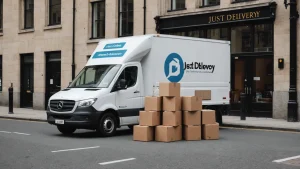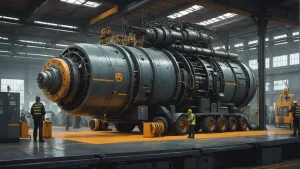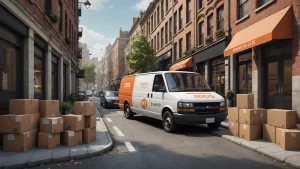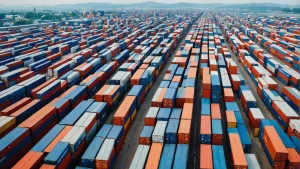Business owners, pay heed: Cold chain logistics is not merely a buzzword, it’s a revolution.
With a grasp of what cold supply chain logistics are, you’ll maximize productivity, cut your losses, and drive your business into a profitable future. Discover how employing cold chain cross docking strategies ensures your perishable goods move swiftly from truck to truck, reducing storage times and enhancing operational efficiency.
Cold chain logistics.
An intimidating term that opens doors to a world of seamless supply and cold chain solutions; a game-changer that keeps perishable products fresh, maintains quality, and drastically reduces wastage. Experience the transformation that timely delivery can offer, ensuring your perishable goods are managed efficiently with minimal waste and optimal freshness.
Think of a perfectly ripened avocado from a farm several hundred miles away, landing on your customer’s plate, unspoiled.
That’s the power of cold chains for business owners.
Arm yourself with this knowledge and set your business miles ahead of the competition.

Lower your delivery costs by 23%
How we reduce costs:
- No delivery vehicle expenses
- Optimized local routes
- Pay-per-delivery model
- Average 23% delivery cost reduction
Unraveling the Cold Chain Logistics Process: A Must-Know for Every Business Owner
Cold chain logistics is a process that ensures product quality and safety
This system consists of refrigerated storage, transport, and monitoring methods
Advances in technology are vital to the efficiency of the cold chain logistics operation
Understanding the Basics of Cold Chain Logistics
Cold chain logistics might sound like a cool new buzzphrase, but it’s been a game-changer in the business world for quite a while. Cold chain shipping enables the transportation of temperature-sensitive goods from one location to another while maintaining optimal conditions. The importance of this system lies in preserving product quality and ensuring public safety – imagine a shipment of vaccines reaching a destination tainted or a delivery of premium steaks arriving spoiled. Not quite appealing, right?
The Components of Cold Chain Logistics
This vital operation wouldn’t be possible without the integral parts that comprise cold chain logistics – refrigerated storage, transportation, and an effective monitoring system. The refrigerated storage keeps products at desired temperatures before dispatch, ensuring that they remain in optimal condition. Carefully monitored transportation ensures these conditions endure during the product’s journey. Accurate, real-time monitoring of temperatures provides the assurance businesses need – no second guessing or stressing over unforeseen temperature variations. Explore how businesses can manage backlogged orders in cold chain logistics to maintain product integrity and customer satisfaction.
Refrigerated Storage
Refrigerated storage is the first step in the cold chain process. It ensures that products are kept at an optimal temperature from the point of manufacture or harvest to the point they are ready to be shipped.
Transportation
Transport comprises the next step in the game of cold chain logistics. Specialized vehicles equipped with refrigeration systems keep products at the desired temperature during transit.
Monitoring Systems
Lastly, digital monitoring systems track and record temperature data throughout the journey. This data can provide invaluable insights and reassurance for businesses.
The Role of Technology in Cold Chain Logistics
No discussion of modern business practices would be complete without mentioning technology. The supremacy of technology is undeniable when it comes to facilitating critical processes like cold entire supply chain logistics – be it through IoT devices for temperature monitoring or AI algorithms for predicting potential disruptors. It’s technology, with its constant evolution, that enables businesses to administer these complex systems with ease, efficiency, and accuracy. As the tech world advances, so do the opportunities for better, more efficient cold chain logistics. Understanding the nuances between advancing scheduling methods and reverse scheduling can significantly amplify the effectiveness of your technology-driven logistics operations.
Overcoming Challenges in Cold Chain Logistics: A Pathway to Business Success
Identifying Common Challenges in Cold Chain Logistics
Cold chain logistics, while transformative, presents a net of complex hurdles that businesses need to navigate wisely. Key problematic areas comprise temperature ranges and deviations, visibility gaps, and regulatory compliance. Understanding demand predictions is essential for optimizing the efficiency of cold chain logistics, making the mastery of forecasting methods critical.
Temperature Variances
The core of cold chain logistics is managing temperature – a make-or-break aspect of the supply chain. It’s where even minor temperature fluctuations can signify a failed shipment, resulting in financial losses and a damaged reputation. A survey indicates that 20% of businesses face dissatisfied customers due to temperamental variances in their cold chain. Understand the significance of implementing just-in-time manufacturing strategies in cold chain logistics to enhance efficiency and minimize the risk of temperature-related failures in your supply process.
Lack of Visibility
Opaque supply chains can be a thorny issue, plunging you into the realm of unnecessary risks – lost assets, dissatisfied customers, or in worst-case scenarios, a legal battle. Nearly a third of companies struggle with a ‘black box’ scenario, impeding them from tracing products accurately for safety recalls.
Regulatory Compliance
In the rapidly evolving regulatory landscape, staying updated with the changes is as crucial as the temperature control itself. Falling afoul of these regulations may result in hefty fines, causing a dent in profits. Reports show that 15% of businesses had to pay penalties due to non-compliance with the rules.
Implementing Effective Solutions to Overcome Challenges
With the right strategies, businesses can circumvent these obstacles. Investments in technology, staff training, and appropriate documentation can turn problems into opportunities for improvement and growth. Enhance your company’s CSA scores and promote a culture of safety by adopting these effective strategies to transform challenges into benchmarks for excellence.
Embracing Advanced Technology
Technological innovations serve as a lifeline for businesses grappling with cold chain logistics issues. The use of real-time temperature monitoring systems can help in maintaining the appropriate temperature range during transport. Around 1 in 4, businesses have reported a 25% improvement in cold chain efficiency after implementing tracking technology.
Training Staff
Well-trained staff contributes to successful cold chain management. Regular training initiatives targeting regulatory updates, product handling, and correct documentation processes can minimize the risk of non-compliance and bad deliveries. According to a report, 35% of businesses observed substantial improvement in their delivery accuracy with staff training.
Proper Documentation
Accurate documentation is more than just a requirement; it’s a business safeguard. From tracking each product’s journey to helping you in audits and complying with regulations, documentation holds the key to successful cold chain logistics. An estimated 30% of businesses credited streamlined documentation for their improved recall processes.
Navigating the cold chain logistics terrain can seem daunting, yet with the right strategies, it is a pathway to business success. Acknowledging the potential obstacles and implementing effective solutions are the first steps to robust and efficient cold chain operations here. By aligning cold chain logistics with your business goals, you can unlock unprecedented growth.
The Impact of Cold Chain Logistics on Your Business: Why It Matters
Ensuring Product Quality and Safety
Cold chain logistics plays a crucial role in maintaining the quality and preserving the safety of temperature-sensitive products. This is especially applicable to industries such as the food and beverage industry, pharmaceuticals, and chemicals, where product integrity is paramount to user safety, regulatory compliance, and business growth. Enhance your cold chain management efficiency! Discover straightforward methods to calculate your vehicle’s load capacity and adjust your cargo optimally for superior preservation and cost-effective operations.
Consider fresh produce, for example, which requires controlled temperatures to prevent spoilage. Cold chain logistics management ensures fruit, vegetables, and other perishable items reach the consumer in perfect condition, extending the product’s shelf life. Uncover the significance of effective management in cold chain outbound logistics and how it plays a crucial role in the seamless delivery of fresh produce to the market.
Equally important is the pharmaceutical and food industry. Medicines and vaccines often require low-temperature storage to retain their efficacy. In this case, any compromise in the cold chain logistics process can pose severe health risks to end consumers and result in significant financial losses for the manufacturing companies. Explore how the optimization of outbound cold chain logistics ensures the safe delivery of pharmaceuticals and perishable goods, maintaining their quality and effectiveness all the way to the consumer.
Enhancing Customer Satisfaction
Consumer satisfaction can be a key differentiator for businesses operating in competitive markets. Maintaining product quality through cold chain logistics directly impacts customer satisfaction and loyalty.
For instance, when a company can consistently deliver fresh, unspoiled produce to the market due to an effective cold chain management system, customers are likely to be pleased with the product’s quality and possibly become recurring buyers. Understanding the integral elements of outbound logistics can further enhance a company’s ability to deliver premium-quality items to its consumers, fostering loyalty and repeat business.
Furthermore, the advent of online shopping has stretched the scope of cold chain logistics to involve home deliveries. A well-managed cold chain ensures that temperature-sensitive goods reach customers in excellent condition, thereby elevating the purchasing experience and fostering customer loyalty.
Boosting Business Reputation and Profitability
Capable cold chain logistics can significantly enhance a business’s reputation. Consumers, more so now, are well-informed and place a high value on companies that prioritize product safety and quality. A company with a robust cold chain logistics system is often seen as reliable, contributing substantially to its reputation in the market.
Moreover, efficient cold chain management helps mitigate product loss due to spoilage, which directly impacts a company’s bottom line. Investing in robust cold chain logistics can result in increased savings and profitability in the long run.
Perhaps less tangible but equally relevant is the fact that up-to-date cold chain systems can convey a company’s commitment to sustainability. A sustainable, cold chain storage, not only reduces waste but also signals to consumers and investors an alignment with increasing global efforts toward environmental responsibility. This, too, can contribute to a positive business image and profitability.
The Future of Cold Chain Logistics: Preparing Your Business for Success
Emerging Trends in Cold Chain Logistics
New tech advances are paving the way for smarter, more efficient cold chain logistics. Notable among them are AI, which has added an unprecedented degree of intelligence to cold chain logistics companies, the Internet of Things (IoT), enabling real-time monitoring of shipments and blockchain technology, providing complete transparency and security.
The AI Influence
Artificial Intelligence (AI) is stepping up its game, helping businesses predict transportation delays, thus minimizing disruptions. Artificial Intelligence machines can analyze a massive array of data points to foresee potential issues before they arise – a classic case of prevention being better than cure.
IoT: En Route to Efficiency
The Internet of Things (IoT) is lighting the path to efficient supply chain monitoring. Sensors are stationed on transport vessels, reading and transmitting temperature, humidity, and other critical data in real-time, ensuring goods arrive in pristine condition.
Unveiling Blockchain
Blockchain technology is bringing unmatched transparency to transportation practices. It’s an immutable, decentralized ledger, helping stakeholders track and verify transactions, vastly increasing trust and efficiency in the logistics sphere.
The Role of Sustainability in Cold Chain Logistics
Green is the new black in cold chain logistics. As planetary health spirals up the global agenda, the sector is feeling the pressure to shift toward environmentally-friendly practices. Businesses that adapt to this shift not just survive but thrive. Explore how adopting sustainable transportation methods can enhance your profitability and contribute to a greener planet.
Green Logistics: It’s Time to Adapt
Indeed, green is no longer a mere bandwagon to jump on—it has become a necessity. From solar-powered warehouses to biofuel vehicles, businesses are exploring sustainable alternatives to reduce their carbon footprint.
The Triple Bottom Line
A systematic approach towards sustainability in cold chain logistics can lead to a triple bottom line—good for people, profits, and the planet. A sustainable cold chain can improve a brand’s reputation, boost customer loyalty, and lead to measurable cost savings in the long run.
Preparing Your Business for the Future of Cold Chain Logistics
The realm of cold chain logistics is evolving at lightning speed. As a business owner, it’s crucial to stay a step ahead, prepare for the unexpected, and grasp the opportunities that these changes bring forth.
Embrace the Digital Revolution
The first step in future-proofing your business is embracing the power of technology. Utilizing AI, IoT, and blockchain technology in your logistics process could be a game-changer. From predictive analytics to real-time tracking, this digital revolution can enhance efficiency and transparency in your supply chains like never before.
Go Green or Go Home
The call for sustainability is growing louder each day. By establishing eco-friendly practices in your operations, you pave the road for a more sustainable future, supporting climate change mitigation efforts while also increasing your business’s bottom line. It’s not just the right thing to do—it’s smart business.
Invest in Training and Development
Preparing your staff for this technology-driven world is crucial. Investing in the right training programs can help your team upskill, enabling them to adapt to these new technologies and implement them in your operations seamlessly.
Embracing the Cold Chain Revolution
Cold chain logistics outshine traditional methods with its assured product quality, cost-efficiency, and reduced waste. It’s no wonder this innovation is shaping a new future for businesses. Understanding the crucial steps of cold chain outbound logistics can further enhance efficient product delivery to customers.
Business owners, it’s your move. Explore the possibilities of deploying cold chain logistics within your operations. The edge it can provide in ensuring product safety, consumer satisfaction, and sustainability could be the competitive advantage your business needs.
Now, how will you begin incorporating cold chain logistics into your existing process flow? It’s an operation transformation in the making, one refrigerated package at a time.
Remember, growth is found not only in expanding markets but also in improving the way we reach those markets. Change may seem cold, but in this case, it has never been more invigorating. Let’s keep the conversation going – what’s your first step in embracing cold chain logistics?





























